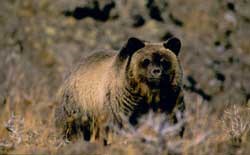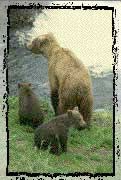|
High-Tech/Low-Tech Grizzly Bear Research in Ross Lake National Recreation Area, North Cascades National Park and the Okanogan National Forest May - September, 1999 
Background Until the early 19th century, grizzly bears ranged throughout western North America from the Arctic Ocean down the west side of Hudson Bay and the Mississippi River, south down the spine of the Sierra Madre mountains deep into northern Mexico. Their decline matched the westward migration of Euro-Americans who, as direct competitors for many of the same resources, rapidly reduced the number of grizzly bears through habitat alteration and direct killing. Grizzly bears' once vast range shrank within one hundred years to a number of small, isolated pockets. Like isolated water drops, these continued to shrink and disappear until today grizzly bears occupy approximately 2% of their original range in the contiguous 48 states. A similar, though not quite as pervasive, pattern of habitat and population fragmentation and local extinctions occurred in Canada. There are four remnant populations left within the contiguous states, three of which are shared with Canada. One survives in the North Cascade mountains of Washington and British Columbia. These bears have been federally listed as Threatened in the US, state listed as Endangered in Washington and provincially designated as Threatened in British Columbia. Listings in the US and Canada are somewhat different - for example, Canada does not have an Endangered Species Act at this time - but have the same general meanings. It is not known how many grizzly bears make up the remnant in the North Cascades. Grizzly bears are extremely difficult to count under the best of circumstances. They are secretive and occupy large homeranges. Grizzly bears do not defend discrete territories, but use areas sometimes as great as several hundred square miles in which to find food, mates and den sites. So it is difficult to quantify the number of bears living in any one area. In the North Cascades the task is made even more difficult, as bears have large areas of extremely rugged terrain and dense forests within which they can avoid detection by people. Current estimates of grizzly bear numbers in the North Cascades are based on information gained from observations by agency employees and the public. These include tracks, distinctive cache sites and observations of the animals themselves. Approximately 10 - 20 grizzly bears live within Washington's North Cascades Grizzly Bear Recovery Area, roughly defined as the area between Interstate 90 in the south, up the Columbia and Okanogan Rivers on the east to the international boundary; then back south generally along the Mount Baker-Snoqualmie National Forest's western boundary. In British Columbia's North Cascades Grizzly Bear Population Unit (bounded by the Trans-Canada Highway, Highways 8, 5A and 3 and the international border), the minimum population estimate is 17 grizzly bears. Bears living in the area of the international boundary are assumed to occupy homeranges spanning the 49th parallel. How many grizzly bears are "dual citizens", and therefore potentially counted twice, is not known. Because grizzly bear observations are so fleeting in the North Cascades, very little is known about them here. The distribution of confirmed observations ranges from near Mt. Rainier in the south through the northern end of the range. Female grizzly bears have been observed with cubs, so we know some bears find each other to mate. Other than that, no one knows what habitat types and foods they prefer here, how they are distributed across the landscape or how they respond to human development - all things that can vary from area to area. This information is needed about bears in order to help them recover in number and live as wild, free-ranging populations for perpetuity. A common way to learn more about animals in the wild is to capture them, attach radio collars or other devices, then track their movements using radio or global positioning system receivers. Attempts to capture grizzly bears on both sides of the border have met with failure - due for the most part to the small numbers of bears and the remoteness and inaccessibility of the land in which they live. While there are no viable substitutes for radio- or GPS- tracking bears for gaining much of the data we need, there is another method that is being tried to glean some very basic information from grizzly bears in the North Cascades. 
1999 Inventory: low tech meets (very!) high tech This first year of a proposed 3-year study was funded by the Seattle City Light Wildlife Research fund and supervised by WSU's Dr. Rob Wielgus. The study area fell within North Cascades National Park, Ross Lake National Recreation Area and the western Pasayten Wilderness (Okanogan National Forest). Sampling methods followed a similar inventory conducted in the British Columbian Cascades in 1998. The project was endorsed by the North Cascades Grizzly Bear Management Subcommittee, made up of managers from the National Park Service, US Forest Service, US Fish and Wildlife Service, Washington Department of Fish and Wildlife, Washington Department of Natural Resources and the British Columbia Ministry of Environment, Lands and Parks. The study's field tools were simple: barbed wire and nose-curdling scent lure. Romain and her crew set out a total of 50 barbed wire hair snags to "capture" hair samples for DNA analysis. The hair snags consisted of strands of barbed wire strung near a scent lure. As there was no food reward, bears visiting the sites did not learn to connect any residual human scent in the area with food; the bear's biggest reward was the chance to rub and roll in some truly fetid odor, in much the same way pet dogs enjoy rolling in a variety of smelly things. Loose hairs were caught on the barbs when bears walked past the wire to investigate the scent. The hair samples were collected every few weeks. The wires were removed after the sampling period, and the lure's stench wore off within a few weeks. The high-tech part of the study is just beginning, with the DNA analysis of the 468 hair samples the crews collected this summer. It is a time-consuming job, requiring the careful sorting and preparation of each of the hair samples. Species, sex, and relatedness to other bears are determined through mitochondrial DNA amplification from cells in the roots of each hair. Graduate student Romain will be conducting these analyses under the supervision of the University of Idaho's Dr. Lisette Waits, a leading expert in bear genetics. The study's objectives also include analyzing the hair samples to determine what each bear's diet consisted of over the past year or so. Washington State University's Dr. Charlie Robbins and his students have developed methods for quantifying bear diets by analyzing stable isotopes stored in an animal's hard tissues, such as hair and bone. Stable isotopes from vegetation and animal matter are stored in different ways, depending on whether they originate from vegetation, marine meat (migrating salmon) or terrestrial meat sources (fresh water fish, mammals, insects). Isotopes stored in bone reflect an animal's diet throughout the course of its life. Hairs are shed seasonally, so they store information about what a bear has been eating during the time the hair was growing. Bear researchers know grizzly bears' diets vary from area to area depending on what's available. Some recent studies conducted by Robbins' lab have quantified geographic differences in diet. One study they conducted identified salmon as a primary food source for grizzly bears living in the Columbia Basin in the late 19th and early 20th century. Another WSU study indicated an average of 51% of a Yellowstone grizzly bear's diet consists of meat in some form, but a grizzly bear's diet in and around Glacier National Park consists of only about 11% meat, and 89% vegetation. Grizzly bears' diets on Alaska's Kenai Peninsula are made up of nearly 78% meat - no great surprise, given the availability of salmon in that area. Robbins' lab will identify what the bears of the North Cascades relied on over the past year by analyzing at least part of the 468 hair samples collected this past summer. Field Sampling Results, May 24 - September 20, 1999 Overall, 71% of the hair snags were visited by bears. In the spring, when bears were concentrated into very limited low-land foraging areas, 83% of the sites were visited by bears. In the late season, 61.8% of the sites were visited. A total of 468 hair samples were collected throughout the summer. Of these, 233 were collected in the early season and 235 in the late. Forty-one of the snags were set in the Okanogan National Forest's Pasayten Wilderness, for 305 samples. The other nine were set in North Cascades National Park and Ross Lake National Recreation Area, for 163 samples. Incidentally, the hair samples' colors supported patterns that have shown up in the North Cascades National Park Service Complex's three year-old bear database: about 50% of the samples were brown or similar shades, the other half black. The NPS database also indicates a rough half and half split between coat colors observed in and around the park. But we can't say what this means about the results of the DNA analyses which Ms. Romain is starting work on. Both grizzly bears and black bears come in a wide assortment of colors. Many "black" bears in the North Cascades are blonde, brown, cinnamon and multi-colored. Grizzly bears also come in colors ranging from nearly white to black. So we must wait for the lab work to be done to know whether grizzly bears visited any of the hair snags. The analyses are expected to be complete by sometime in January 2000. |
Last updated: February 14, 2025
